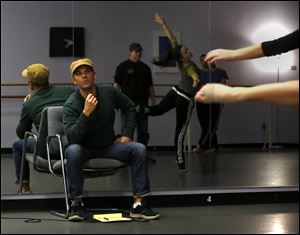
REVIEW
Local artists rise to challenge of ‘Rite of Spring'
Toledo ballet, symphony triumph in show’s debut
2/6/2016
Counterpoised against this testament of personal sacrifice, the program’s second half offered a new choreographic vision of Stravinsky’s Rite of Spring by Toledo Ballet Director Michael Lang.
The Machine raged — or was it rage against the Machine?
Struggle and sacrifice allegorically exploded in primal energy in Friday night’s collaboration between the Toledo Ballet and the Toledo Symphony Orchestra.
Toledo Symphony’s premiere Friday night of Tchaikovsky’s Symphony No. 1, subtitled Winter Dreams began the foray in the Toledo Museum of Art Peristyle.
Grappling to reconcile his own artistic voice with accepted classical forms, the composer wrote and reworked this piece incessantly. Driven to the brink of emotional breakdown by critics, in the end he cast aside all outside influence. He returned to his original artistic intent, only to pay the price of waiting 12 years for anyone to actually perform the work.
The final score is a romantic idyll, full of Tchaikovsky-appeal, which the symphony more than honored with a brilliant performance. Masterfully, they painted a winter landscape of color, melody, and energy which drove steadily onward from dark brooding to a joyous, unmistakably Russian, climax.
Counterpoised against this testament of personal sacrifice, the program’s second half offered a new choreographic vision of Stravinsky’s Rite of Spring by Toledo Ballet Director Michael Lang. Cognitively demanding and brutally evocative, this modern adaptation continued the legacy of this ever-controversial work.
Amid the sinewy stretching of bodies in battlesque conflict, peripatetic images of crucifixion, separation, abasement, and domination led the audience through a complex web of struggle for meaning, purpose, and equality in a world which clearly promises little or none.
From the opening interplay of “The Man and Woman,” a clear subtext was driving Lang’s vision that would prove relentless until the final beats of the score. The haunting birth dance of Mother and Child; the subtle wedge of manipulation driven; the subjugation and exploitation of the Lessers; scenarios linked in a chain of force impelling the viewer to take notice, open their eyes, and understand that sacrifice is still rife in our world today.
Congratulations to the company of four dancers and three actors who channeled their energy and psyche to bring this difficult and challenging work to life. A complex score, demanding moves, and extreme emotional material were executed with a disturbing brilliance.
As for the symphony, Stravinsky’s score is probably the single most complex of its day. Extreme tessituras, psychotic time changes, and incredibly complex orchestration give even world-class virtuosos pause.
The symphony rose to the occasion with bravado. Savage string-work, undulating winds, brilliant brass, and clamoring percussion expertly melded to the dance in a single artist focus where the sum of the parts constituted a riveting whole. Congratulations to Maestro Stefan Sanderling and the orchestra for outstanding work on this monumental piece of music.
The program will be repeated at 8 p.m. today in the Toledo Museum of Art Peristyle, 2445 Monroe St. Tickets and more information at 419-246-8000 or toledosymphony.com.
Contact Wayne F. Anthony at: classics@theblade.com.